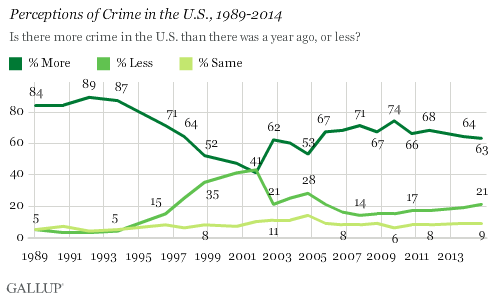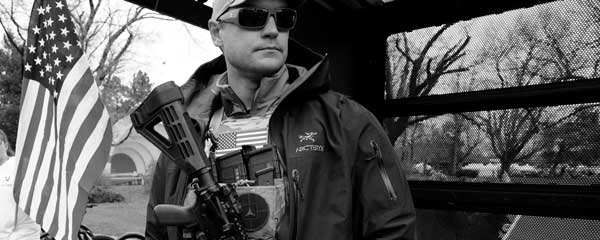Story Highlights
- One of smallest majorities in 10 years, 63% say crime is up
- Americans less likely to say crime is up in their own area (44%)
- Perceived crime levels at odds with reality
WASHINGTON, D.C. -- A majority of Americans say there is more crime in the U.S. than there was a year ago, as is typical for this long-term Gallup trend. The current 63% of Americans who believe this is well below the recent high of 74% in 2009 and is one of the lowest percentages since 2004. However, it is still much higher than the historic low points between 1999 and 2001.

As the percentage of Americans who say crime is up hits one of its lowest points in the past 10 years, more than one in five Americans (21%) say crime is down. This is the highest since 2005. Meanwhile, 9% of Americans say the level of crime has remained the same.
Americans are historically less likely to believe crime is up in their area than believe this to be the case nationally, and that remains true today, with 44% saying local crime is up. Nearly one in three Americans (32%) say crime is down in their area, while about one in five (19%) say it has remained the same. These figures have not changed much over the past decade, with each of this year's figures just a percentage point off from its respective 10-year average.

Perceptions of Crime Still Detached From Reality
With a handful of exceptions, government statistics show serious crime has decreased nearly every year from 1994 through 2010. According to the U.S. Department of Justice, Bureau of Justice Statistics, the overall violent crime rate for rape, sexual assault, robbery, aggravated assault and simple assault fell from 80 victimizations per 1,000 persons in 1994 to 19 per 1,000 in 2010. In the first decade of that trend, public opinion followed, with the percentage perceiving crime was up falling from 87% in 1993 to 41% in 2001. But this shot up to 62% in 2002 -- around the time of the Washington, D.C.-area sniper shootings -- and has remained fairly high ever since.
Though serious crime did increase in 2011 and 2012, Americans' perceptions of crime did not grow in subsequent polls, underscoring that federal crime statistics have not been highly relevant to the public's crime perceptions in recent years.

Bottom Line
For more than a decade, Gallup has found the majority of Americans believing crime is up, although actual crime statistics have largely shown the crime rate continuing to come down from the highs in the 1990s and earlier.
Compared with previous decades, perceptions of crime in the U.S. have calmed somewhat. Still, majorities of Americans maintain that there has been an increase in crime from the previous year. Because Americans are more pessimistic about crime in the U.S. as a whole as opposed to their own localities, this could suggest that many base their views on what they hear about crimes that take place outside of their own hometowns. Some argue that consumption of news media plays a role in this by exposing Americans to crimes that they may perceive as more widespread than actually is the case.
But even in their own localities, sizable portions of the population view crime in their area as having increased over the past year, and at several points over the past few decades, majorities have held these views.
Survey Methods
Results for this Gallup poll are based on telephone interviews conducted Oct. 12-15, 2014, on the Gallup U.S. Daily survey, with a random sample of 1,017 adults, aged 18 and older, living in all 50 U.S. states and the District of Columbia. For results based on the total sample of national adults, the margin of sampling error is ±4 percentage points at the 95% confidence level.
Each sample of national adults includes a minimum quota of 50% cellphone respondents and 50% landline respondents, with additional minimum quotas by time zone within region. Landline and cellular telephone numbers are selected using random-digit-dial methods.
View complete question responses and trends.
Learn more about how Gallup Poll Social Series works.

